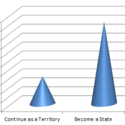In 2012, the people of Puerto Rico voted on the question of the political status of Puerto Rico.
There were two questions on the ballot. First, voters were asked whether they wanted territory status to continue.
- 970,910 voted “No”
- 828,077 voted “Yes”
If Puerto Rico doesn’t continue as a territory, there are only two possible alternatives: statehood and nationhood, either simple independence and or in an association with another nation. The United States has ‘free association’ arrangements with three former parts of a territory in the Pacific.
The second question in the plebiscite asked voters which of the alternatives to territory status they preferred.
- 834,191 voted for statehood.
- 454,768 voted for free association.
- 74,895 voted for independence.
On this question, 61.2% chose statehood. 33.3% wanted Puerto Rico to be a separate nation in a free association with the United States. 5.5% chose independence.
Though the two questions were separate, we can also clearly see that the number of people voting for Statehood was larger than the number voting to continue as a territory:
- Continue as territory: 828,077
- Become a State: 834,191
The governor of Puerto Rico and majorities in both houses of its Legislative Assembly oppose statehood. The governor and most of the majorities want an unprecedented “commonwealth status” that Federal officials of both national political parties have said is impossible for constitutional and other reasons. The position of the governor and his allies in the legislature is that territory status should continue until the Federal government changes its mind on their proposal for a “commonwealth status.”
Because congressional lobbying by the governor threatened to prevent Federal action on granting the self-determination request of Puerto Rico, President Obama proposed another plebiscite, limited to the possible alternatives to territory status. Congress agreed and the proposal was enacted into Federal law.
The territorial government has not acted to have the Federally authorized plebiscite occur, however, because of the division in the Legislative Assembly between the governor and his allies and the growing faction of their party that wants nationhood in an association with the U.S.








No responses yet